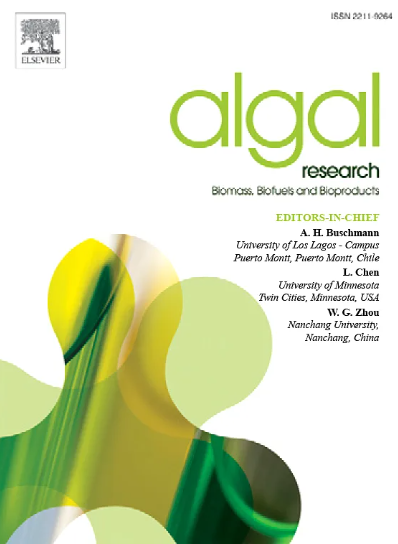The determining regions, specific genes and markers of sex in Pyropia haitanensis (Bangiales, Rhodophyta)
IF 4.6
2区 生物学
Q1 BIOTECHNOLOGY & APPLIED MICROBIOLOGY
Algal Research-Biomass Biofuels and Bioproducts
Pub Date : 2024-10-30
DOI:10.1016/j.algal.2024.103780
引用次数: 0
Abstract
Genetic studies have confirmed that the sex of Pyropia haitanensis belongs to the genotypic determination. However, the genes involved in the sex determination have not yet been studied. In this study, two double haploid (DH) populations of the male and female were established using the sex-sectored blades produced by a crossing experiment of P. haitanensis, and the sex-linked regions (SLRs) were identified by BSA-Seq, which were located on chromosome 4. HiFi sequencing was performed on the SLRs of female and male for reassembly and gene annotations, and the results showed that the SLRs of female and male contained 93 and 94 genes with sizes of 0.32 and 0.31 Mb, respectively. In the SLRs of female and male, there was a sex-determining region (SDR) containing 5 and 3 genes, respectively. In addition, gene conversion of the SDRs resulted in non-Mendelian genetic segregation with a segregation ratio of male: female to be 4:0, 3:1, 1:3 or 0:4. Two female-specific genes (PhF00071 and PhF00072) were found in the female SDR. Gene cloning revealed that the full-length CDS of PhF00071 was 816 bp, encoding a protein containing an RWP-RK domain; while the full-length CDS of PhF00072 was 858 bp, encoding a protein that did not contain any known domains. qRT-PCR revealed that the expression levels of the two female-specific genes were significantly increased during the formation of female germ cells (P < 0.05). In addition, primers were designed using the specific sequences of female and male SDRs, and the genomic DNA of female, male and heterozygous strains were amplified by PCR. The results proved that only one specific band could appear in female or male strains, while both female and male-specific bands appeared in heterozygous strains. This study lays a foundation for further elucidating the mechanisms of sex determination and sexual maturity in P. haitanensis.
海桐(Bangiales, Rhodophyta)性别的决定区域、特定基因和标记
遗传学研究证实,海蟒蛇的性别由基因型决定。然而,参与性别决定的基因尚未得到研究。本研究利用杂交实验产生的雌雄双单倍体(DH)叶片建立了两个雌雄双单倍体群体,并通过BSA-Seq鉴定了位于4号染色体上的性连锁区域(SLRs)。对雌性和雄性的SLRs进行了HiFi测序,以进行重新组合和基因注释,结果显示雌性和雄性的SLRs分别包含93和94个基因,大小分别为0.32和0.31 Mb。在雌性和雄性的SLR中,性别决定区(SDR)分别包含5个和3个基因。此外,SDR 的基因转换导致了非孟德尔遗传分离,雌雄的分离比分别为 4:0、3:1、1:3 或 0:4。在雌性 SDR 中发现了两个雌性特异基因(PhF00071 和 PhF00072)。基因克隆显示,PhF00071 的全长 CDS 为 816 bp,编码一种含有 RWP-RK 结构域的蛋白质;而 PhF00072 的全长 CDS 为 858 bp,编码一种不含任何已知结构域的蛋白质。qRT-PCR 显示,这两个雌性特异基因的表达水平在雌性生殖细胞形成过程中显著增加(P < 0.05)。此外,利用雌性和雄性 SDRs 的特异序列设计引物,对雌性、雄性和杂合株的基因组 DNA 进行 PCR 扩增。结果表明,雌性或雄性菌株只能出现一条特异性条带,而杂合菌株则同时出现雌性和雄性特异性条带。这项研究为进一步阐明海鲮的性别决定和性成熟机制奠定了基础。
本文章由计算机程序翻译,如有差异,请以英文原文为准。
求助全文
约1分钟内获得全文
求助全文
来源期刊

Algal Research-Biomass Biofuels and Bioproducts
BIOTECHNOLOGY & APPLIED MICROBIOLOGY-
CiteScore
9.40
自引率
7.80%
发文量
332
期刊介绍:
Algal Research is an international phycology journal covering all areas of emerging technologies in algae biology, biomass production, cultivation, harvesting, extraction, bioproducts, biorefinery, engineering, and econometrics. Algae is defined to include cyanobacteria, microalgae, and protists and symbionts of interest in biotechnology. The journal publishes original research and reviews for the following scope: algal biology, including but not exclusive to: phylogeny, biodiversity, molecular traits, metabolic regulation, and genetic engineering, algal cultivation, e.g. phototrophic systems, heterotrophic systems, and mixotrophic systems, algal harvesting and extraction systems, biotechnology to convert algal biomass and components into biofuels and bioproducts, e.g., nutraceuticals, pharmaceuticals, animal feed, plastics, etc. algal products and their economic assessment
 求助内容:
求助内容: 应助结果提醒方式:
应助结果提醒方式:


